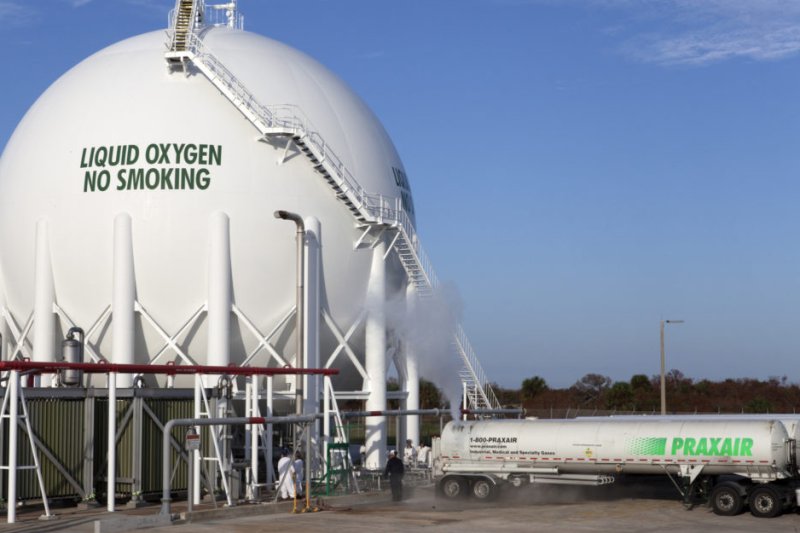By
Paul Brinkmann

Trucks offload liquid oxygen at a storage tank inside Kennedy Space Center in Florida. Photo courtesy of NASA
Sept. 7 (UPI) -- A pandemic-related shortage of a key rocket propellant, liquid oxygen, could force rocket launches to be postponed in coming months, possibly delaying important scientific and national defense missions, industry observers said.
In fact, NASA already pushed back the launch of its Landsat 9 climate and land use satellite from California by one week to Sept. 23 because of delivery problems for required liquid nitrogen. Those are related to the liquid oxygen supply chain snarls, the agency said.
Supplies of liquid propellant in the region aren't the problem, Del Jenstrom, a NASA project manager for the Landsat program, said at recent a public conference.
"There's plenty of liquid nitrogen in the Los Angeles area. The problem is they need trucks to bring it up to Vandenberg," he said. "Because of the pandemic ... liquid oxygen deliveries have been paying much higher premiums than liquid nitrogen deliveries, and LN2 trucks have been converted to carry liquid oxygen."
Pandemic-related demand for liquid oxygen by hospitals, especially in rural areas, has strained the delivery network for the precious commodity. More truck drivers are needed to deliver the supercooled element to both hospitals and launchpads, but finding more drivers trained to handle it is difficult.
"Current pandemic demands for medical liquid oxygen have impacted the delivery of the needed liquid nitrogen supply to Vandenberg [Space Force Base]," NASA said in a blog post about the shortages.
"We are talking about a vast amount of oxygen for a launch," said Csaba Palotai, a physics professor at Florida Institute of Technology in Melbourne. For example, one SpaceX launch of a Falcon 9 rocket can use about 40,000 gallons of the supercooled element.
"It is likely that launches will be delayed significantly due to the priority given to the healthcare industry, especially if the number of people who need oxygen continues to increase," Palotai said.
The reason for the shortage: Hospitals require oxygen to treat many COVID-19 patients, who are filling intensive care units and acute beds throughout the country. Hospitals in the South have had to borrow oxygen from other states, according to reports.
Super-cooled liquid oxygen is ignited to produce thrust for rockets. Hospitals heat the gas to create pure oxygen to assist in coronavirus care.
In addition to NASA, SpaceX cited the liquid oxygen shortage in public comments recently.
SpaceX launches will be "impacted" by the lack of liquid oxygen this year, company president Gwynne Shotwell said during a space conference panel discussion in Colorado on late last month.
Two days later, SpaceX founder and CEO Elon Musk -- Shotwell's boss -- posted on Twitter that launch delays due to liquid oxygen shortages were "a risk, not yet a limiting factor."
The biggest challenge for the increased use of liquid oxygen is transportation, Rich Craig, vice president of technical and regulatory affairs at the Compressed Gas Association, a trade association, said in an interview.
That's because it is stored at minus-300 degrees F, which requires specialized tanker trucks and trained drivers, he said.
"Our members are making all the liquid oxygen they can, but in some areas, Florida for example, that's just not enough," Craig said. "So they are bringing in supplies from elsewhere. That means more transport time."
He said the association's priority is to make sure hospitals and patients receive the treatments they need, he said.
"They're bringing in supplies from far away to meet local demands, so this is a problem [regional oxygen shortages] that has just compounded," Craig said.
As a result, the industry is recruiting drivers as fast as possible, he said. Many drivers quit during the early days of the pandemic, and weeks of training are required.
United Launch Alliance, which plans to launch NASA's Landsat 9 mission, said the Sept. 23 launch date is uncertain because of the ongoing regional shortages.
The satellite is designed largely to enhance agriculture and forestry management by providing data on soil moisture and woodland health.
ULA confirmed that the "supply chain delivery shortage is due to the increased demand for medical liquid oxygen for COVID patients."
No comments:
Post a Comment